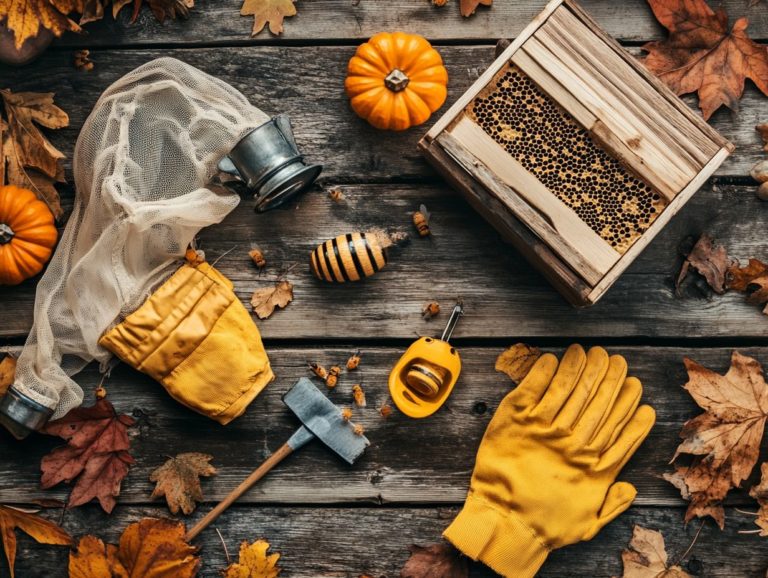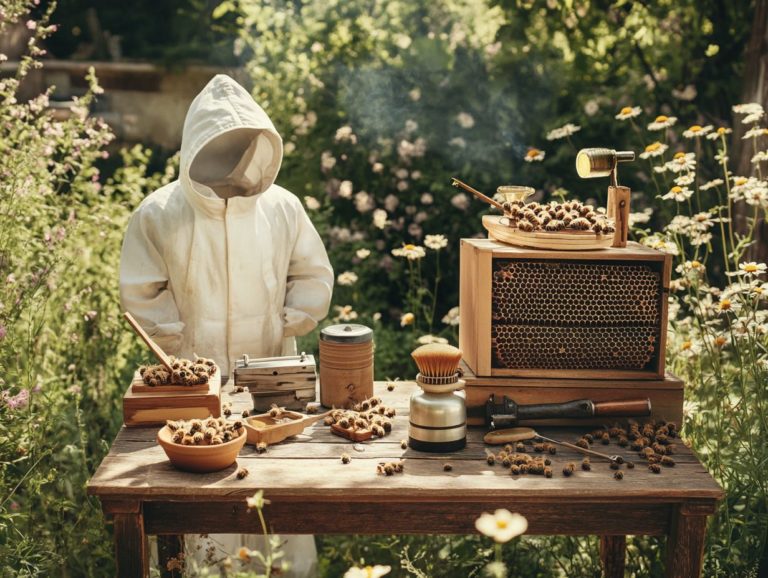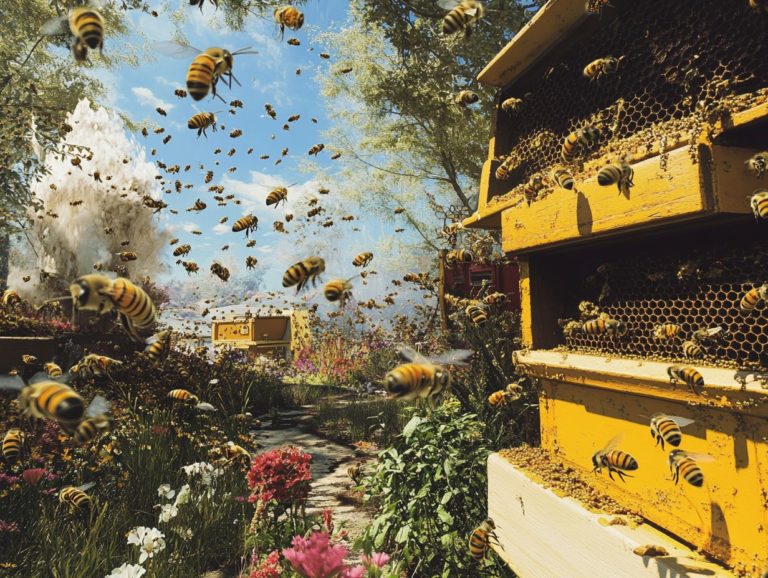Best Beekeeping Books for Understanding Equipment
Are you prepared to immerse yourself in the fascinating realm of beekeeping? Whether you’re embarking on this journey for the first time or seeking to refine your expertise, the right resources can significantly elevate your experience. Don t miss out on these essential resources!
This article showcases ten essential books that provide invaluable insights into the equipment and techniques of beekeeping. From grasping the various types of hives to identifying essential tools and avoiding common pitfalls, these guides will equip you with the knowledge necessary to cultivate a flourishing apiary.
Prepare to transform your beekeeping adventure!
Contents
- Key Takeaways:
- 1. “The Beekeeper’s Handbook” by Diana Sammataro and Alphonse Avitabile
- 2. “The Backyard Beekeeper” by Kim Flottum
- 3. “Beekeeping for Dummies” by Howland Blackiston
- 4. “The Bee Book” by Charlotte Milner
- 5. “The Beekeeper’s Bible” by Richard A. Jones and Sharon Sweeney-Lynch
- 6. The Complete Idiot’s Guide to Beekeeping by Dean Stiglitz and Laurie Herboldsheimer
- 7. Better Beekeeping by Kim Flottum
- 8. The Thinking Beekeeper by Christy Hemenway
- 9. The Beekeeper’s Problem Solver by James E. Tew
- 10. “The Practical Beekeeper” by Michael Bush
- What Are the Essential Equipment for Beekeeping?
- Frequently Asked Questions
Key Takeaways:

- Invest in a comprehensive guide like “The Beekeeper’s Handbook” for a thorough understanding of beekeeping equipment and techniques.
- “Beekeeping for Dummies” and “The Backyard Beekeeper” are great beginner-friendly options for learning about equipment and starting your own hive.
- Don’t forget about maintenance and repairs! “The Thinking Beekeeper” and “The Practical Beekeeper” provide valuable insight on keeping your equipment in top shape.
1. “The Beekeeper’s Handbook” by Diana Sammataro and Alphonse Avitabile
The Beekeeper’s Handbook, penned by the knowledgeable duo Diana Sammataro and Alphonse Avitabile, stands as a critical resource for you, whether you’re just starting or already an experienced beekeeper. This book offers a wealth of insights into beekeeping practices and honey bee biology. It also covers effective management techniques that will help you maintain robust, thriving bee colonies.
It dives deep into hive management nuances and provides practical advice for addressing common challenges. This makes it a must-have in your backyard beekeeping library.
The handbook is thoughtfully organized into clear, accessible sections. It covers essential topics like seasonal hive management, disease control, and strategies to maximize honey production. The authors expertly highlight the significance of understanding bee behavior and physiology, equipping you with the foundational knowledge necessary for successful hive stewardship.
Its relevance in today s beekeeping community is truly undeniable, especially as environmental challenges loom over bee populations. For beginners, you ll discover hands-on, practical tips that make complex procedures seem manageable. Seasoned beekeepers will uncover advanced techniques to optimize their hives.
This book will guide you through the exciting world of beekeeping!
2. “The Backyard Beekeeper” by Kim Flottum
Kim Flottum’s The Backyard Beekeeper is your go-to manual for embarking on your backyard beekeeping journey. It offers invaluable insights into bee garden design, essential supplies, and effective strategies for honey production. All of this lays a solid foundation for your success in beekeeping.
As you delve into practical beekeeping techniques, you’ll discover the critical importance of understanding bee behavior and lineage. This knowledge boosts hive productivity and improves honey quality.
With an emphasis on maintaining bee health, you’ll learn the ins and outs of regular hive inspections and how to spot signs of disease. You will also understand the crucial roles that proper ventilation and nutrition play in nurturing a thriving colony.
Don t underestimate the significance of a well-designed bee garden; it serves as a sanctuary for pollinators, brimming with a rich biodiversity of flowering plants. A particularly noteworthy tip is to plant native species, which not only attract bees but also ensure they have a steady food supply throughout the growing season.
Sprinkled with anecdotes from seasoned beekeepers, the text instills confidence. It demonstrates that even novices like you can achieve success with the right knowledge and dedication.
Start your beekeeping journey today and explore the wonders of working with these incredible pollinators!
3. “Beekeeping for Dummies” by Howland Blackiston
Beekeeping for Dummies by Howland Blackiston is your ideal gateway into the world of beekeeping. It masterfully simplifies complex concepts and common challenges, transforming them into easily digestible sections that enable you to grasp the fundamentals with confidence and enthusiasm.
This guide’s step-by-step approach is a breath of fresh air, making it incredibly accessible even if you’ve never encountered bees before. You’ll find specific chapters dedicated to essential topics like hive management and pest control. For example, the section on identifying signs of disease within the colony clearly outlines the symptoms and provides practical solutions for treatment.
The book s comprehensive coverage of seasonal tasks helps you prioritize what needs attention throughout the year. This effectively alleviates the initial overwhelm that often accompanies the start of this rewarding hobby. Ultimately, this book stands as your encouraging companion, making your beekeeping journey both manageable and enjoyable.
4. “The Bee Book” by Charlotte Milner
Charlotte Milner’s The Bee Book serves as an enchanting gateway into the captivating realm of bees. You’ll discover a diverse array of bee species and delve into their intriguing behaviors. You’ll also appreciate the essential role they play in our ecosystem. This book is a must-read for anyone with an interest in beekeeping and bee conservation.
With engaging illustrations and compelling anecdotes, Milner elaborates on the intricate connections between bee biology and practical beekeeping techniques. As you turn the pages, you’ll find yourself immersed in discussions about hive management, pollination, and the environmental challenges confronting these vital insects.
Bee conservation is urgent. Milner highlights the necessity to protect our declining bee populations that are crucial to our food supply and biodiversity. By nurturing a deeper understanding of these interconnections, The Bee Book inspires you not only to become a responsible beekeeper but also to champion the protection of these remarkable creatures.
5. “The Beekeeper’s Bible” by Richard A. Jones and Sharon Sweeney-Lynch
The Beekeeper’s Bible by Richard A. Jones and Sharon Sweeney-Lynch serves as your ultimate guide to the fascinating world of beekeeping, offering a wealth of information that delves into the history of this ancient craft. You’ll uncover a variety of resources and techniques designed to maximize honey production, all while immersing yourself in the vibrant culture surrounding beekeeping.
As you explore the pages, you’ll encounter intriguing insights into how various cultures have engaged with beekeeping over the centuries. The book beautifully illustrates traditional methods that continue to shape modern practices today. From the opulent honey of ancient Egypt, revered as a symbol of wealth and protection, to the innovative organic beekeeping techniques currently on the rise, you’ll witness the remarkable evolution of these practices and the crucial role bees play in our ecosystem.
With dedicated sections on honey production and an array of enticing recipes that incorporate bee products, the authors invite you whether you’re an aspiring beekeeper or a culinary enthusiast to discover the versatility of honey, propolis (a sticky substance produced by bees), and beeswax (a natural wax secreted by bees). Embark on this exciting journey to truly appreciate these amazing insects and the precious treasures they create.
6. The Complete Idiot’s Guide to Beekeeping by Dean Stiglitz and Laurie Herboldsheimer

The Complete Idiot’s Guide to Beekeeping by Dean Stiglitz and Laurie Herboldsheimer offers you a welcoming and straightforward entry into the fascinating world of beekeeping. Tailored specifically for beginners, it simplifies complex processes and presents essential beekeeping techniques in a way that’s not only easy to grasp but also implement.
This invaluable guide breaks down key practices into manageable steps, ensuring that you never feel overwhelmed. With insightful perspectives on hive management, pest control, and seasonal care, you ll be well-equipped to navigate your journey into beekeeping with confidence.
The inclusion of checklists and practical tips allows you to move through the process systematically, so you won t miss any critical aspects of your new endeavor. This approachable format encourages you to experiment and learn at a pace that feels right, making it a critical resource for anyone eager to explore the joys of keeping bees.
7. Better Beekeeping by Kim Flottum
In Better Beekeeping, Kim Flottum offers you a refreshing perspective on the philosophy of beekeeping, skillfully blending traditional practices with innovative techniques designed to enhance both bee health and hive management for beekeepers of all skill levels.
Throughout the book, Flottum emphasizes the importance of understanding the intricate relationships within the hive and how outside influences such as climate and local flora impact bee behavior and vitality. He provides you with practical insights on creating more favorable environments for your bees, from selecting the ideal hive locations to employing natural pest management strategies.
By advocating for community engagement among beekeepers, he encourages you to share knowledge and resources, highlighting the vital role bees play in our ecosystems. Flottum’s exploration of the evolving nature of beekeeping underscores the adaptability required of today’s beekeepers and stresses the urgency of addressing ongoing environmental challenges to ensure the health and sustainability of bee populations for the future.
8. The Thinking Beekeeper by Christy Hemenway
*The Thinking Beekeeper* by Christy Hemenway invites you to embrace a natural beekeeping approach that emphasizes a holistic management style for bee colonies. Through engaging stories, Hemenway beautifully illustrates the interconnectedness of bees, the environment, and sustainable practices.
By highlighting principles such as minimal intervention, the use of top-bar hives, and organic methods, she draws a clear contrast between her philosophy and conventional beekeeping, which often leans heavily on chemicals and intensive hive management strategies.
One particularly compelling case study in the book showcases a beekeeper s transformative journey after adopting natural methods. This exciting shift not only created healthier bees but also nurtured vibrant ecosystems around his apiaries.
You are encouraged to reflect on how these practices can enhance bee well-being while nurturing a deeper connection with nature. Ultimately, this approach contributes to the resilience of bee populations and the flourishing of agricultural landscapes.
9. The Beekeeper’s Problem Solver by James E. Tew
James E. Tew’s The Beekeeper’s Problem Solver is an essential resource for you, addressing the common challenges faced in beekeeping. This guide offers practical solutions and expert advice to help you navigate the difficulties that arise during hive inspections and throughout the beekeeping season.
The book organizes crucial issues such as pests, disease management, and environmental stressors that impact bee health and productivity. For example, it provides clear methods for identifying signs of Varroa mites parasites that can harm bee colonies along with integrated pest management strategies to effectively combat them.
Tew emphasizes the significance of regular hive inspections. He shares practical tips, urging you to use smoke wisely and maintain a calm demeanor to minimize stress on your bees. The book also covers vital preventive measures, like ensuring your colonies have adequate food supplies and selecting appropriate hive locations to help you sidestep common pitfalls that could threaten your colony’s stability.
10. “The Practical Beekeeper” by Michael Bush
“The Practical Beekeeper” by Michael Bush offers practical methods for effective beekeeping. You’ll learn how to manage hives and harvest honey successfully while understanding bee behavior.
By incorporating hands-on techniques such as seasonal hive inspections, optimal spacing of frames, and keen observation of foraging patterns, you can refine your beekeeping methods. This book encourages you to grasp the natural instincts and social structure of bees, paving the way for better decision-making and enhanced hive productivity.
Embracing a practical mindset enables you to tackle challenges with confidence, ensuring your colonies not only survive but truly flourish. Engaging with these methods will deepen your appreciation for your bees, enriching your beekeeping experience and ultimately leading to bountiful harvests.
What Are the Essential Equipment for Beekeeping?
Essential equipment for beekeeping consists of a variety of supplies that are crucial for both your journey as a beginner beekeeper and for managing your hives effectively. This equipment ensures the health and productivity of your honey bee colonies.
Consider the carefully constructed hives available, such as the popular Langstroth hive, known for its ease of access and efficient honey extraction. Alternatively, you might explore the more natural top bar hives that encourage bee self-management. Each hive type serves a unique purpose tailored to your beekeeping style.
Essential tools like hive tools for inspecting and manipulating frames, smokers to calm your bees, and protective gear such as veils and gloves are critical for maintaining safety during hive inspections. With the right equipment, you’ll boost your chances of honey production and protect both yourself and your bees, fostering a harmonious environment for your thriving colonies.
What Are the Different Types of Hives and How Do They Work?

Understanding the various types of hives is crucial for your success in beekeeping. Each hive design, whether it s the Langstroth hive, top bar hives, or box hives, comes with its own set of unique benefits and functionalities tailored to specific beekeeping goals.
By evaluating the mechanics of each hive type, you can make well-informed decisions that will directly influence honey production efficiency and the overall health of your bee colonies. The Langstroth hive is often preferred for its straightforward extraction and management, making your life a little easier. On the other hand, top bar hives encourage a more natural environment for the bees, which can enhance their well-being, but they may require a bit more attention from you.
Box hives, while potentially more cumbersome, offer excellent insulation for your bees. When choosing a hive, consider your personal preferences, the space you have available, and your local environment to ensure your choice aligns with your specific beekeeping objectives.
What Are the Necessary Tools for Beekeeping?
The essential tools for beekeeping are crucial elements that enable you to conduct hive inspections, master beekeeping techniques, and manage your bee colonies with finesse. With the right equipment in your arsenal, you can confidently monitor hive health and harvest honey while minimizing stress on your buzzing companions.
Employing a smoker is a game changer; it calms the colony, allowing you to inspect the hive without causing unnecessary disturbance. Hive tools become critical as you pry apart frames and handle the bees safely. Investing in a high-quality bee suit shields you from stings while granting you the freedom to interact with your hives.
Regular maintenance of these tools think cleaning and proper storage can significantly enhance their lifespan and efficiency, ultimately fostering the health and productivity of your colonies.
How Can a Beginner Choose the Right Equipment?
As a beginner beekeeper, selecting the right equipment is crucial for avoiding common pitfalls and ensuring a fruitful start to your beekeeping journey. This choice requires careful consideration of the beekeeping supplies that align with your goals.
When embarking on this adventure, evaluate factors such as your budget, local climate conditions, and specific beekeeping objectives. For example, if you live in a colder region, you may need insulated hives, while those in warmer climates should prioritize materials that encourage airflow.
Your equipment choices should resonate with your goals, whether they involve honey production, pollination, or educational pursuits.
To make informed decisions, research various tools, prioritize quality over cost-saving measures, and seek advice from seasoned beekeepers. This thoughtful approach boosts your chances of success and enhances your overall beekeeping experience.
What Are the Common Mistakes to Avoid When Buying Beekeeping Equipment?
New beekeepers often fall into traps when buying equipment. Overbuying can strain your budget and complicate your experience. Additionally, opting for equipment that lacks quality can lead to setbacks in your beekeeping journey.
For instance, choosing the wrong hive design or materials may affect both the durability of your hive and the health of your bees. This ultimately detracts from the joy of beekeeping.
Educating yourself about essential tools and their functions allows you to differentiate between what is genuinely necessary and what is simply a marketing ploy. It’s wise to start with a few high-quality essentials and gradually expand your kit based on your individual needs and observations. This method ensures that your beekeeping practice remains efficient and sustainable over time.
How Can One Maintain and Repair Beekeeping Equipment?
Maintaining and repairing your beekeeping equipment is essential for effective hive management. It ensures the longevity and efficiency of your supplies while preventing issues that could jeopardize the health of your bees.
Regular cleaning is vital for your equipment. Accumulation of debris or wax can lead to increased wear and reduced operational efficiency. Establishing a schedule for thorough inspections allows you to spot signs of deterioration, such as cracks or rust, early on. Identifying wear and tear before it escalates can significantly prolong the lifespan of these essential tools.
Consider using non-toxic cleaners, which are safe for both you and your bees. Habitually replacing worn parts before they fail is a smart practice. Keeping detailed records of your inspections and repairs helps track equipment performance, enabling informed decisions that enhance your hive’s overall health.
Frequently Asked Questions
For more in-depth knowledge, beekeepers can explore bee literature and beekeeping history to understand the evolution of apiculture and modern practices.
What are some of the best beekeeping books for understanding equipment?

For those interested in practical beekeeping and honey production, “The Practical Beekeeper” by Michael Bush, “The Buzz About Bees” by Amber Bradshaw, and “Beekeeping for Dummies” by Howland Blackiston are excellent resources.
Some of the best books for understanding beekeeping equipment include “The Beekeeper’s Handbook” by Diana Sammataro and Alphonse Avitabile, “The Beekeeper’s Bible” by Richard Jones and Sharon Sweeney-Lynch, and “The Backyard Beekeeper” by Kim Flottum.
Start your beekeeping journey today by selecting the right equipment!
Why is it important to understand beekeeping equipment?
Understanding beekeeping equipment is crucial for successful beekeeping. It allows beekeepers to properly care for their bees and maintain healthy hives while ensuring the safety of both the bees and the beekeeper.
A detailed knowledge of beekeeping supplies and bee behavior can significantly improve honey harvest and overall hive productivity!
Discover the Essential Beekeeping Gear!
These books cover a wide range of equipment, including hives, frames, hive tools, protective gear, bee feeders, and extractors.
They provide detailed information on how to use and maintain each piece of equipment. You’ll also find insights on specific hive types, such as the Langstroth hive, box hives, and top bar hives!
Are these books suitable for beginners?
Yes! These books are fantastic resources for beginner beekeepers.
They provide comprehensive information and step-by-step instructions on setting up and managing a beehive, along with helpful tips and troubleshooting advice. A beginner’s guide like “Beekeeping for Dummies” is especially useful!
Can these books be used for any type of beekeeping?
Absolutely! These books are suitable for all types of beekeeping, whether backyard or commercial.
They offer valuable insights and techniques that can be applied to any beekeeping operation. These guides are invaluable for understanding the nuances of natural beekeeping and traditional methods!
Do these books have illustrations or photos?
Yes! These books are filled with vibrant illustrations and photos that visually explain the different types of equipment and how to use them.
These visuals make learning fun and easy, helping readers grasp complex topics like bee biology and honey bee research!
Ready to dive into the world of beekeeping? Grab these books and start your rewarding journey today!





